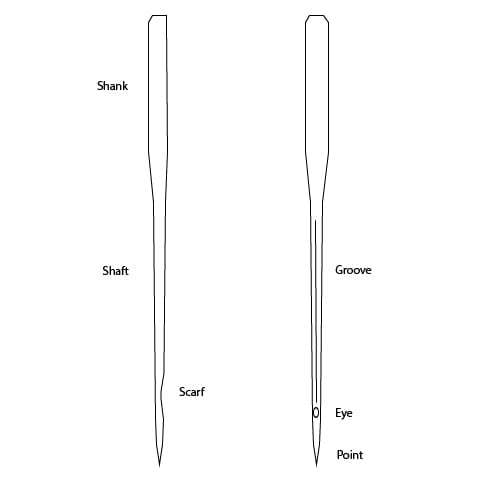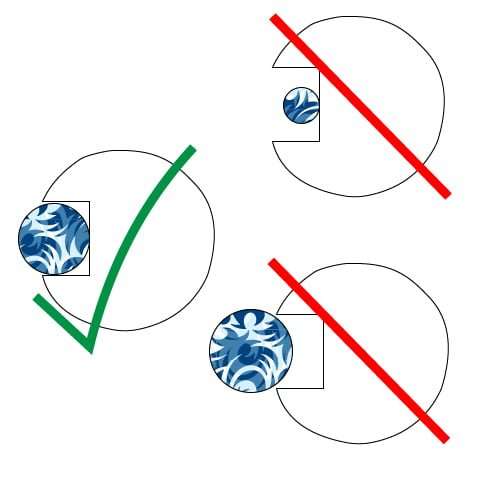Needle types may confuse many of us. Not to mention what they’re made of, who makes them, well it’s a lot of information.
All needles are not created equal
You knew that though. There’s hand stitching, tapestry needles and then there are machine needles. And there are a lot of things about machine needles that impact your stitch quality. I’m not talking longarm machine needles here, they still confuse me. All those numbers on that box remind me of everything I still have to learn. But I can tell you a thing or two or ten about domestic machine needle types.
There are many parts to a needle…you’ll be surprised!
We all know the eye, the point, and probably the shank. For longarm machines, there is a round shank, but all domestic machines have a flat shank. It makes sure that the needle goes in the right way, and that the eye is at 12H00. Yip, that’s important, because if the needle was slightly off, your thread would well, shred.
Now, something you may not have noticed on a machine needle is the groove. It’s a little slip above the eye of the needle but below the shank. That’s the bit where your thread gets nestled in so that it gets pulled through the needle smoothly.


The other thing you may not have noticed is that little scarf at the back of the needle – look on the flat side of the shank, hold it up and then take a look. That little part is the scarf, and that’s where the mechanism that brings your bobbin thread up runs over the needle, getting ready to lock the stitch.
So what happens when your thread doesn’t fit into the groove – it causes your thread to shred! The friction of the thread against the needle causes it to fray if it isn’t nestled into that groove properly.
Get your groove on
Here’s what your needle will do to a thread that doesn’t fit into that groove:
If it’s too thick, it won’t fit in the groove, the thread can jam and thread will strip, break, miss stitches, and all those other frustrating things that we experience.
If it’s too small, the situation is much the same. It creates excessive amounts of thread in the groove, which will reduce the size of the loop, skip stitches, and create uneven tension.
What’s in a number
The numbering system of needles is another one of those where one standard was adopted, and then another was also added so that everyone was happy. The needle size is determined by the diameter of needle blade times 100. So a needle that is 1mm will be a size 100. This is the metric size. The second number on the needle package is the Singer system, thus we have a 90 or 0,9mm needle as a 14 in Singer speak.
So what size needle to use with what thread?
- Very fine needles, 60/8 and 70/10 are for fine threads like 100wt or 60wt threads
- Fine needles, 80/12 are for fine threads like 50wt – most quilters use this size needle for piecing
- Medium needles 90/14 for threads around 40wt
- Large needles 100/16 for 30wt and heavier threads
Brilliant – size counts, but what about universal, embroidery and all the other needle types in classifications?
Size is not the only thing that plays a role – you’re also looking at that eye and the groove size remember? Which brings me to the next bit of learning and information you need to know.
Topstitch
These needle types have a larger eye so that you can use all those specialized threads on your beautiful fabric.
Embroidery Needle

This is specially designed for machine embroidery using Rayon, Polyester or Cotton machine embroidery threads. This needle features a wider hole to allow the thread to pass freely. Another feature is a pontoon scarf with an oversize bump to reduce the chance of skipped stitches which can result when the fabric is flexing up and down rapidly with the fast-moving needle.
Universal

The name says it all, doesn’t it? It has a slight ball point that makes is versatile. Remember that a ballpoint needle is not meant for woven fabrics, so this one is a bit sharper than a ballpoint. It is the most commonly used needle for synthetic woven and natural fibres. It’s also suitable for most thread types.
Sharp or Microtex

The sharp point of this needle is designed for stitching tightly woven fabrics and is ideal to use with silk. The sharp point will give you a perfect straight stitch, making it an ideal needle for topstitching, and patchwork. This needle is my new favorite.
Quilting Needle

It has a strengthened shaft to help reduce needle deflections when it penetrates multiple layers of fabric.
Just before we wrap this up, here’s what you’ve learned about needle types:
- Needles have many parts, and those things all matter
- What those numbers of the packets mean – Metric and Singer systems have led to the numbering that we know
- The point of the needle gives its name, and it affects the eye too:
- Universal – great for everything
- Topstitch – bigger eye
- Embroidery – well it is meant for working fast
- Sharps – nicely sharp point for woven fabrics and gives a great straight stitch
- Quilting – extra strong shaft to make it move smoothly through many layers
